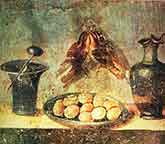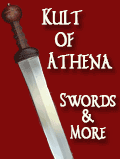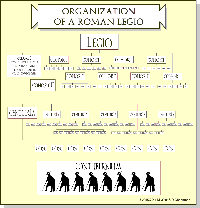The Structure and Ranks
of a Roman Legion
Introduction to a Roman legion
The main fighting unit of the Roman army was the legion. During the first three centuries of the empire the army contained between 25 and 34 legions. Each legion was made up of about 5000 men recruited from the citizens. Although the soldiers of the legion were Roman citizens, they were drawn from all walks of life and legions often consisted of natives from conquered countries.
The legion contained within its ranks troops trained and equipped to perform many duties in wartime and peace. Although the vast majority of soldiers served as heavy infantry, other legionaries fought as cavalry, archers or light infantry. Other troops operated artillery such as the ballista, onagar and scorpio The troops were however not solely prepared for combat. Legionaries regularly served as engineers constructing fortifications, roads and bridges. As the legion counted among its complement a vast number of men with special skills, it was in many ways self-supporting. A large part of its military equipment could be produced by craftsmen drawn from the ranks. Soldiers trained as surveyors, engineers and architects ensured that the legion needed little outside help for its building requirements. Administrative duties were performed by other legionaries both within their unit as well as in the community
Each legion carried a number and a name, e.g. Legio X Gemina (the tenth 'twin' or 'double' legion), to which honorary titles like pia fidelis (dutiful and loyal) could be added.
The numbering and naming of units followed no rational pattern. As many of the formations originated in the various armies of the civil wars following the death of Julius Caesar, several legions carried identical numerals or nicknames. Even new legions that were formed were named and numbered according to the fancies and whims of the emperor. The sense of individuality provided by these numbers and titles was reinforced by the use of different unit symbols and signs like bulls, boars or capricorns.
The organization of a legion
The strength and organisation of the legions changed over time and was uniform throughout the army. Generally speaking however, the legio was organised in ten cohorts. These cohorts consisted each of three manipuli, literally 'handfuls', which were in their turn subdivided in two centuries or 'hundreds'. These centuries were made up of a number of contubernia or 'tentparties'. Although the name century would seem to indicate a unit of a hundred soldiers, this unit could comprise anything from 30 to over 200 troops. The usual establishment strength however is reckoned to have been 80 men. From the second half of the first century AD in at least some of the legions the first cohort was reorganised in five double strength centuries while the remainder continued to be organised in the old manner.
In addition to the regular organisation of cohortes, manipuli and centuries, there were other sub-units for the equites legionis - the legionary cavalry - and the antesignani or lancearii, the legionary light infantry. The exact details of their organisation is still unclear even today. For a variety of duties provisional units known as vexillationes or numeri were formed. The strength and organisation of these provisional units varied greatly and was only in part based on the more regular subdivisions within a legion.
The chain of command within a legion
Each legion was designed to be a self contained team and usually contained 4,200 men; and 300 cavalry. The ranks could increase to 5,000 men if needed. There was a rigid framework and chain of command as shown here.
Legatus legionis (Legate)
First in command
The overall legion commander. The post was usually filled by a senator, appointed by the emperor, who held command for 3 or 4 years, although he could serve for a much longer period. In a Roman province with only one legion, the legatus was also the provincial governor. In such circumstances, the Legatus was dual-hatted as both Legion Legate and Imperial Legate. The Legion Legate also served as commander of the auxiliary units attached to the legion though they were not formally a part of the legion's command structure.
Tribunus laticlavius
Second in command
Broad Band Tribune: Named for the broad striped tunic worn by men of senatorial rank, this tribune was appointed by the emperor or the Senate. Though generally young, he was more experienced than the tribuni angusticlavii, he served as second in command of the legion, behind the legate. Because of his age and inexperience he was not the actual second in command in battle, but if the legate died he would take command of the legion.
Praefectus castrorum
Camp commandant and Third in command
Camp Prefect: The Camp Prefect was third in command of the legion. Generally he was a long serving veteran from a lower social status than the tribunii whom he outranked, and who previously had served as primus pilus and finished his 25 years with the legions. He was used as a senior officer in charge of training a legion, though he could also command a cohort of auxiliaires.
Tribuni angusticlavii
Admin Officers
Narrow Band Tribunes: Each legion had five lower ranking tribunes, who were normally from the equestrian class and had at least some years of prior military experience. They often served the role of administrative officers. This tribunate was often a first, but optional, step in a young man's political career (see cursus honorum).
Primus pilus
Senior centurion
Literally First File: The Primus Pilus was the commanding centurion of the first century, first cohort and the senior-most centurion of the entire legion. (Unlike other cohorts, the first cohort had only one javelin century, instead of a "front spear" and a "back spear" century.) The primus pilus had a chance of later becoming a Praefectus Castrorum. When the primus pilus retired, he would most likely gain entry into the equestrian class. He was paid 60 times the base wage. Primus Pilus were also paid more than an average centurion and like a narrowband tribune.
Centuriones ordinarii
Centurion
There were 10 Centurions in a legion. The rank of centurion was an officer grade that held much responsibility, meaning centurions had very good career prospects. The most senior centurion in a legion was known as the primus pilus (first file or spear), who directly commanded the first century of the first cohort and commanded the whole first cohort when in battle. Within the second to tenth cohorts, the commander of each cohort's first century was known as a pilus prior and was in command of his entire cohort when in battle. The seniority of the pilus prior centurions was followed by the five other century commanders of the first cohort, who were known as primi ordines.
The six centuries of a normal cohort, were, in order of precedence:
- The forward hastati (forward spears)
- The rear hastati (rear spears)
- The forward principes (forward principal line)
- The rear principes (rear principal line)
- The forward triarii (forward third line)
- The rear triarii (rear third line)
The centuries took their titles from the old use of the legion drawn up in three lines of battle using three classes of soldier. (Each century would then hold a cross-section of this theoretical line, although these century titles were now essentially nominal.) Each of the three lines is then sub-divided within the century into a more forward and a more rear century.
Primus pilus, literally "First File": The Primus Pilus was the commanding centurion of the first century, first cohort and the senior-most centurion of the entire legion. (Unlike other cohorts, the first cohort had only one javelin century, instead of a "front spear" and a "back spear" century.) The primus pilus had a chance of later becoming a Praefectus Castrorum. When the primus pilus retired, he would most likely gain entry into the equestrian class. He was paid 60 times the base wage. Primus Pilus were also paid more than an average centurion and like a narrowband tribune.
Pilus prior: The "front file" centurions were the commanders of the 10 1st centuries within the legion, making them senior centurions of their respective cohorts. While the legion was in battle formation, the Pilus Prior was given command of their entire cohort. The Primus Pilus was also a Pilus Prior, and the most senior of all the centurions within the legion. These positions were usually held by experienced veteran soldiers who had been moved up within the ranks. This rank is subordinate to the Primus Pilus.
Primi ordines: The "ranks of the first [cohort]" were the five centurions of the first cohort, and included the primus pilus. They, excluding the primus pilus, were paid 30 times the base wage. This rank is senior to all other centurions, save the primus pilus and pilus prior.
Other centurions: Each legion had 59 or 60 centurions, one to command each century of the 10 cohorts. They were the backbone of the professional army and were the career soldiers who ran the day-to-day life of the soldiers and issued commands in the field. They were generally moved up from the ranks, but in some cases could be direct appointments from the emperor or other higher-ranking officials. The cohorts were ranked from the first to the tenth and the century within each cohort ranked from 1 to 6, with only five centuries in the first cohort (for a total of 59 centurions and the primus pilus). The century that each centurion commanded was a direct reflection of his rank: command of the 1st century of the first cohort was the highest, and the 6th century of the 10th cohort was the lowest. Paid ten times the basic wage.
Optio
Deputy Centurion
The post of Optio was optional, depending on the will of the Centurion to have a deputy. One for each centurion (59-60), they were appointed by the centurion from within the ranks to act as his second in command and were graded pay twice the basic wage.
Miles gregarius (pl.: Militis Gregarii)
The soldiers
The Roman army maintained a complex position and grading system for its soldiers that reflected the many and varied duties of the Roman army. There were three pay grades within the rank of miles: standard, one and a half, and twice the basic pay rate.
This is very much a simplified breakdown of a legion.
For a more detailed breakdown, see the list of ranks below
The Parts and Sections within a legion
| Antesignani | One name for the light cavalry. The other name was Lancearii |
|
Centuriae or Century
|
A unit of troops with a legion. Mostly 80 strong, but it could actually number anything between 30 to 100 soldiers |
| Cohort | A unit within the legion. A Cohort (about 480 Troops except the First Cohort which was double size.) There were 10 cohorts in a legion. |
|
Equites legionis
|
The light cavalry |
| Lancearii | One name for the light cavalry. The other name was Antesignani |
| Legatus legionis (Legate) | The first in command of a legion |
|
Legio
|
The actual legion itself |
|
Manipuli
|
A division with a legion. There were three manipuli within a cohort each consisting of two centuries |
|
Numeri
|
A unit in a legion where the soldiers had special skills. E.g. bridge building, engineering, administration etc. |
|
Vexillationes
|
A unit in a legion where the soldiers had special skills. E.g. bridge building, engineering, administration etc. |
The ranks within a legion
|
Aquilifer
|
A single position within the legion. The aquilifer was the legion's standard — or Aquila (eagle) — bearer and was an enormously important and prestigious position. Losing the aquila was considered the greatest dishonor a legion could endure. This post therefore had to be filled with steady veteran soldiers, with an excellent understanding of the tactics of the legion. He was graded pay twice the basic wage.
|
|
Centurio: Centurion
|
A commander of one hundred men. Also know as a Centuriones ordinarii
|
| Centuriones exercitatores | The training officer for the cavalry |
| Centuriones lanceariorum | The leader of the legionary infantry known as antesignani or lancearii. |
|
Cornicen
|
The trumpeter. Worked hand in hand with the signifer drawing the attention of the men to the centurial signum and issuing the audible commands of the officers. He was graded pay twice the basic wage.
|
| Cornicularius | An administrative officer within a legion |
| Decanus | Commanded a contubernium or ten men tent party, eight soldiers and two non-combatants. |
| Discentes signiferorum | A trainee standard bearer |
|
Extraordinarii
|
Soldiers set aside for special backup services. This force usually contained 20% of the infantry and 33% of the cavalry
|
|
Hastaii
|
These were the best of the best of the legion and stood on the front line in battles
|
| Hastatus posterior | The deputy to a Hastatus prior |
| Hastatus prior | A high ranking officer within a manipuli |
| Imaginifer | A special position from the time of Augustus onwards. Carried the standard bearing the image of the Emperor as a constant reminder of the troops' loyalty to him. He was graded pay twice the basic wage. |
| Immunes | Immunes were legionary soldiers who possessed specialized skills, qualifying them for better pay and excusing them from labour and guard work. Engineers, artillerymen, musicians, clerks, quartermasters, drill and weapons instructors, carpenters, hunters, medical staff and military police were all immune soldiers. These men were still fully trained legionaries, however, and were called upon to serve in the battle lines when needed. |
| Munifex | The lowest rank in a legion. Equivalent to a private in today's armies |
|
Optio
|
The centurion's second in command. One for each centurion (59-60), they were appointed by the centurion from within the ranks to act as his second in command and were graded pay twice the basic wage.
|
| Pilus posterior | The deputy to a Pilus prior |
| Pilus prior | A high ranking officer witihin a manipuli who also commanded the cohorts |
| Praefectus castrorum | The third in command in a legion |
| Primi ordines | The senior centurions in a legion who commanded the first cohort |
|
Primus Pilus
|
The senior centurion in a legion
|
| Princeps prior | A high ranking officer witihin a manipuli |
| Principales | A non-commissioned officer |
|
Principes
|
These were the second best of the best of the legion and stood on the second line in battles behind the Hastaii
|
| Princeps posterior | The deputy to a Princeps prior |
|
Signifer: Standard Bearer
|
Each century had a signifer (thus, there were 59 in a legion) and within each cohort the 1st century's signifer would be the senior. He was standard-bearer for the centurial signum, a spear shaft decorated with medallions and topped with an open hand to signify loyalty, which was a rallying point for the soldiers. In addition to carrying the signum, the signifer also assumed responsibility for the financial administration of the unit and functioned as the legionaries' banker. He was graded pay twice the basic wage.
|
| Singulares | The auxiliary soldiers |
| Tesserarius: Guard commander | One for each century. They acted as seconds to the Optios and were graded pay one and a half times the basic wage. Keeper of the watchword, administrative assistant to HQ Staff, third in command of a century. These men fought as normal soldiers when the century they were attached to was not in the vanguard. |
|
Trarii
|
Experienced soldiers, who used the same weapons as the Hastaii and Principes, but instead of a pilum, they had a long spear.
|
| Tribuni angusticlavii | Narrow Band Tribunes: Named for the narrow striped (clavi) tunic worn by these men. Each legion had five lower ranking tribunes, who were normally from the equestrian class and had at least some years of prior military experience. They often served the role of administrative officers. This tribunate was often a first, but optional, step in a young man's political career (see cursus honorum). |
| Tribunus laticlavius | Broad Band Tribune: Named for the broad striped (clavi) tunic worn by men of senatorial rank, this tribune was appointed by the emperor or the Senate. Though generally young, he was more experienced than the tribuni angusticlavii, he served as second in command of the legion, behind the legate. Because of his age and inexperience he was not the actual second in command in battle, but if the legate died he would take command of the legion. |
|
Velites
|
The light soldiers. Unlike the Hastaii, they did not have full armour, although they did have a helmet and a shield. They were also armed with a sword, but had a only a short javelin as opposed to a pilum.
|





















